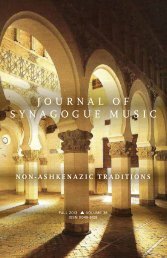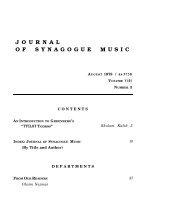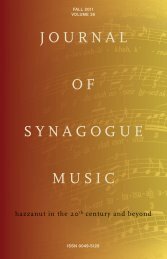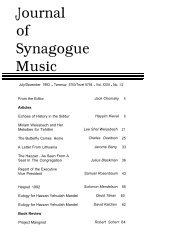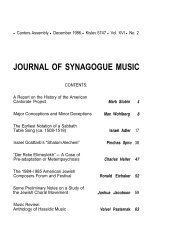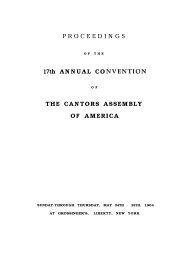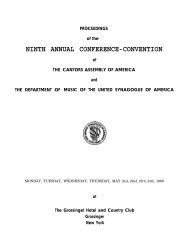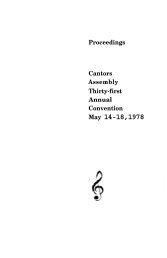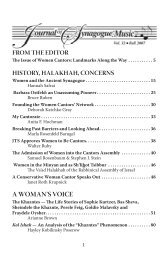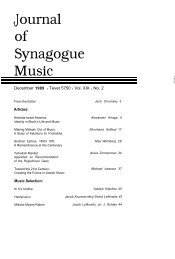Volume 7, Number 3 - Cantors Assembly
Volume 7, Number 3 - Cantors Assembly
Volume 7, Number 3 - Cantors Assembly
Create successful ePaper yourself
Turn your PDF publications into a flip-book with our unique Google optimized e-Paper software.
THE EMERGING IMAGE OF THE CONSERVATIVE CANTOR<br />
17<br />
MAX WOHLBERG<br />
As an adequate discussion of my subject requires a great deal<br />
more time than is at my disposal, I will merely indicate the contours of<br />
the theme and delineate its salient factors.<br />
I will dwell briefly on four areas directly related to my subject.<br />
These are: liturgy, music, congregation and cantor.<br />
As a preface, I wish to point to two trends present throughout our<br />
history. The first, more dominant one, is reverence for tradition. The<br />
second is accommodation to the present.<br />
An observant student of our liturgy cannot help but notice the<br />
frequent recurrence of such words and phrases as: kakatuv, vekhein<br />
katuv, vene-emar, shene-mar, ka-asher amarta and katuv batorah,<br />
shanui banviim, umshulash baketuvim.<br />
These phrases testify to our innate conservatism. While voicing<br />
our prayers we seek affirmation in Scripture. We thus testify to our<br />
link with the past and express our adherence to minhag-tradition,<br />
This powerful trend is responsible for our loyalty to the matbeah<br />
shel tefillah- the liturgical formula of our ancestors, to Biblical cantillation,<br />
to the misinai tunes and to nusah hatefillah.<br />
The conservative movement accepted the principle of religious<br />
continuity and with it the liturgical accretions, some of which, admittedly,<br />
added more bulk than quality to the lofty spirit of our liturgy.<br />
However, it looked with a critical eye on texts which have lost potency<br />
and current applicability.<br />
As a result of such critical considerations, we are gradually beginning<br />
to listen to the words we are about to chant. Perhaps that idea<br />
was implied in the verse (<strong>Number</strong>s 7:89): “Uuevo Moshe el haohel<br />
ledaber ito, uayishma et hakol midaber eilav. ” We are to “listen” and<br />
carefully consider the words we are about to utter. We ought not force<br />
the text into a procrustean world of a preconceived melody but rather<br />
permit the text to dictate and to inspire its appropriate musical<br />
setting.



